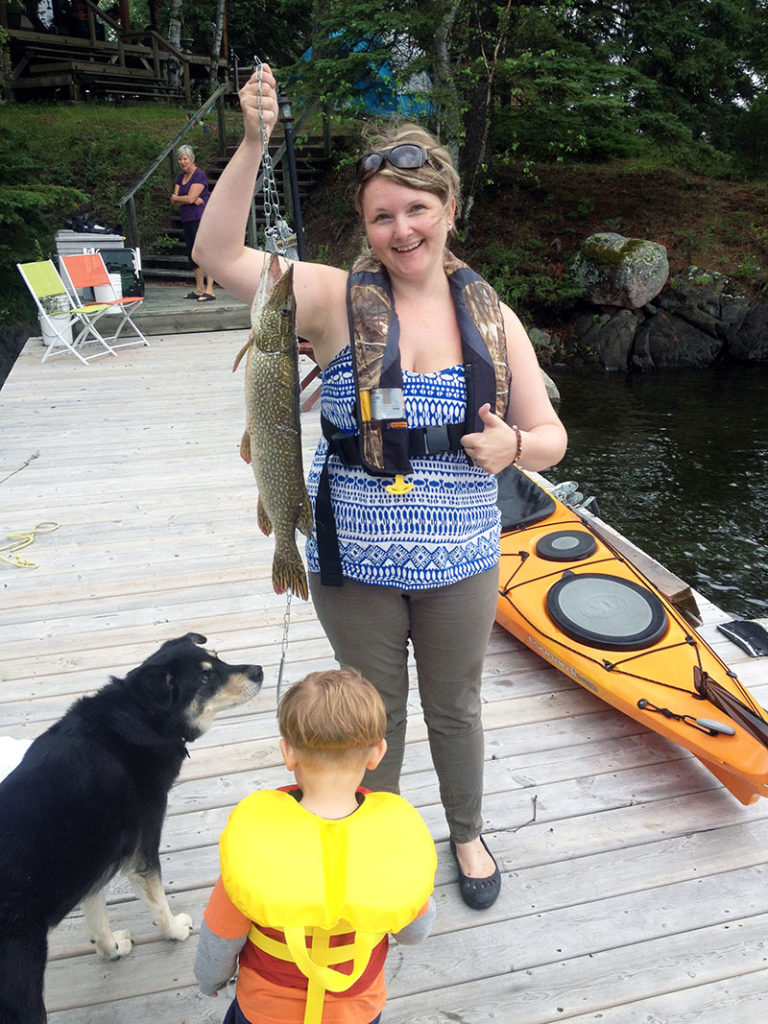
My family and I recently headed to Lake of the Woods for a wonderful week of fun on the water and in the boat, chasing Smallmouth Bass with the fly rods. I had decided I wanted to write an article on catching smallmouth bass but sometimes things change in a hurry… especially when one of Manitoba and Northwestern Ontario’s greatest freshwater predators are hungry and willing to take a fly!
Northern Pike are an extremely populous species and can be found in most Canadian Shield lakes. They are curious, vicious and one heck of a lot of fun to fish. In the early spring during spawning, Pike can be found in shallow waters and weed beds. Eventually they will move to deeper water during the hot summer months. Smaller pike will generally stay in the shallower water where prey is plentiful and structures are available for them to hide under, waiting for an unsuspecting baitfish to swim by. These smaller “hammer handles” is what my wife and I set out to catch on this trip as they are hard fighting, gorgeous emerald tigers and most importantly, they’re delicious!
Fly fishing for Pike is easiest accomplished from a boat or float tube. This allows you to access them at the edges of weed beds found in shallow back bays, or near the mouth of streams and around underwater structures. Look for fallen trees and rocks under water where pike can easily hide and lie in wait for prey.
When first scouting a likely pike location, I like to tie a trolling fly onto my seven weight and cruise the edge of weed beds either in my boat or in a float tube. I find that in clear water or a lake with some tannins (which makes the water a tea colour), a natural fly pattern that imitates a pike’s favourite meal can be extremely effective. In the case of Lake of the Woods, I use a streamer pattern that mimics the perch which can be found in the thousands on the lake. In more turbid waters I will usually pick a brighter pattern that is easier for the pike to see in low visibility.
Once I have located some fish, I switch tactics to a more traditional “false cast” using big popper type flies that mimic frogs, mice and other small rodents. Most top water flies can be found with or tied into weedless hooks. Weedless hooks (generally a heavy piece of monofilament line or thin wire that stops the hook from biting into weeds, wood or getting caught on rocks) are great because they allow you to make casts directly into the weeds, reeds, onto lily pads or any area with cover and branches.
A final thought on casting for pike – fan out your casts so that you’re covering a large amount of water. Focusing on more than one spot gives you ample opportunity to put your fly right under the nose of a waiting fish. Remember that with the exception of poppers, flies tend to be silent so it’s imperative that you give the fish as many opportunities to lay eyes on your fly as possible!
When using a mouse or rodent pattern I tend to strip my line in a steady and moderate to fast action. The goal is to create the look of a panicked rodent looking for a place to get out of the water. When using a popper or frog pattern, I use a one or two fast strips and pause tactic. It imitates a swimming frog and when cast directly onto lily pads or into thick weeds, is a fantastic method to entice a strike.
Using brightly coloured streamers like red and white Deceivers, Wooley Buggers or Zonkers will appeal to the pike’s natural curiosity and territorial instinct and is another great method to attract pike. For those of you that have used the classic “red devil” spoon to catch pike are familiar with this basic pattern.
My wife and I experienced the effectiveness of a red and white streamer pattern when we were working a decidedly well protected bay. As I stripped the line, a nice eater sized pike suddenly shot out from under a submerged tree and hit the fly like a freight train. I had cast to that spot before using a mouse pattern as well as a perch pattern with no luck, but that tree just felt “fishy” to me so I kept trying different tactics. It turned out that a red and white streamer streaking past was the only fly that could convince that beautiful little pike to strike. What a blast!
When fly fishing for these smaller pike my favourite fishing pole to grab is a nine foot, seven weight. This is my go to setup for smallies as well, stiff enough to handle hard fighting welterweight bruisers but light enough to make for an amazing battle where even a smaller fish feels like a goliath!
Note – During spring time pike fishing adventures or when the odds are good that you’re going to be fighting some real monsters, consider switching up to a nine weight rod which is powerful enough to throw massive streamers and is tough enough to land big fish quickly so there is little harm to the fish.
It’s generally a smart bet to rig up two spools. Rig one with a sink tip line and fast sink leader. This will allow you to fish under the surface and troll baitfish patterns. Rig the another with a traditional floating line and leader to keep your poppers high and dry. If you’ve only got one reel, just make sure you have a fast sink leader in your kit.
Even if you plan on keeping a few fish for dinner, and you should, chances are you’re going to be releasing many great fish. Despite the fact that Ontario allows barbed hooks, I strongly recommend that you pinch down your barbs. First of all because barbed hooks are illegal in Manitoba, it just makes sense to make sure your flies are legal everywhere. Equally important barbed hooks leave large wounds on the fishes mouth when removed. This can leave the fish prone to infection and suffering.
These kinds of trips for smaller pike take you deep into smallmouth bass territory and if you head out at the right time of day (early mornings or after dinner) you can find yourself battling both pike and bass. So be prepared for tired arms, sore fingers and huge smiles at the end of the day when you’re feasting on the delicate and delicious white meat of a properly prepared pike dinner.
Pike makes for amazing table fare. Their meat is delicate and mild tasting, perfect for breading and frying in butter or drizzled in olive oil and baked with lemon. The reason most people seem to shy away from eating this amazing fish is because they’re considered overly boney and hard to clean. Once you learn the basic and easy technique of removing the y-bones from your fillets prepare yourself to enjoy one of the most amazing food fish on the water!

